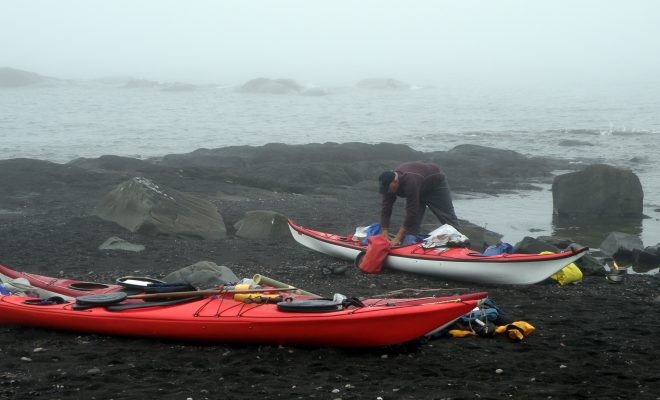The art of packing a sea kayak

BY DAVE FOLEY
I thought I knew how to load a pack. Since the 1960s I had been stuffing backpacks and portage packs for extended hiking and canoe trips. But on our first sea kayaking trip down the coast of Lake Superior through Pukaskwa Provincial Park in 2001, my wife Cyndy and I learned that packing the rounded hard-shell of a sea kayak was a whole lot tougher than shoving gear into a cloth pack. We sat there on the beach at Otter Island trying to get our camping essentials into the narrow hatches. It was frustrating – a real life exercise of trying to fit square pegs into round holes. I had seventeen feet to work with, but what could you shove into the tapering cone spaces at the ends of the kayak? And how were we supposed to push our stuff sacks of clothing through those seemingly way-too-small hatch openings?
Fortunately our guides, Doug and Lorna Pitt, gave us some tips so we could launch without leaving stuff back on the beach. Start with the bow and stern openings, we were told. Find thin items that can be shoved up into these narrow spaces. The most logical pieces were the tent poles and stakes. This meant unpacking the tent, putting the poles and stakes up first. The ends of the kayak also accommodates a fold up saw. Running shoes fit there as well. Shove one shoe up into the tip and then push the other one up behind it. Try small food items. Celery, a sweet potato, a bag of carrots are candidates for tiny spaces. Next add the tent fly and the tent itself.
On hiking and canoe trips we store gear in stuff sacks. The large ones we use on these outings, aren’t suitable for sea kayak trips. With the long narrow boats, small nylon stuff bags work better then the bulkier waterproof dry bags. We might load a dozen or more small packages into the kayak. With so many bags, remembering where stuff is packed becomes a problem. To solve it, we write on a card a listing of the contents of each bag – a job made easier because no two bags are the same color. No more having to look into a stuff sack to determine its contents. Then we make a diagram of the kayak hatches showing which bag goes into which hatch. With this guide, repacking the kayak each day gets easier.
To insure contents stay dry, we line these stuff sacks with trash bags – the smaller “kitchen” bags are idea. Although sea kayak hatches are supposed to be waterproof, it is not unusual to have a “leaker.” For that reason anything we want to be sure stays dry has a layer of plastic around it.
Cook kits gobble up space in hatches; there’s no way to compress them, but the interior of pots can hold packages of food, and drinking mugs.
An advantage of sea kayaking on the Great Lakes is that perishable foods will last longer. With just a layer of plastic or Kevlar between the interior of the kayak and a frigid lake, food stays cold. And if you’ve got the space, you can carry items like watermelon, apples, oranges, and meats. Since there’s no portages or trails to hike, sea kayakers don’t worry about the weight of their gear. Moving all the small stuff sacks and loose items from the kayak to the camp area is accomplished by filling a canvas or nylon duffel bag. With most of the gear zipped into a “body bag,” emptying and transporting gear from the kayak to the camping area isn’t hard. I usually store the body bag in the cockpit or the top of a hatch where it will be easy to access.
Once you’re underway, and you might stay out on the water all day, everything that you will need to access while you’re traveling needs to be in the day hatch or in the cockpit with you. If you’re paddling in rough seas, you may not want to reach back, pull off the cover and then grab items from the day hatch. With that in mind, I keep stuff I will definitely need with me in the cockpit under my spray skirt.
In the cockpit, I have a water bottle and snacks. My camera is sealed in a waterproof dry bag. In addition I have sunscreen, a hat, lip balm, and a knife. In a pocket of my pfd, I carry an emergency whistle. I wear a Seals Sneak zippered spray skirt. This was a good purchase in that I don’t have to detach my spray skirt from the cockpit opening to get under it. I just zip it open and reach through. On the floor of the cockpit I have a Crazy Creek chair covered with a heavy duty plastic bag. If I can’t get my sleeping pad in the storage areas, I will cover it with a plastic bag and put it down beyond my foot pedals in the cockpit. The interior of the cockpit tends to get wet so be sure anything stored there has a waterproof covering. There is space behind the seats and in front of the foot pedals for storing gear if the hatches are full.
Behind me in the day hatch, I have a first aid kit, lunch, a second water bottle, a fleece, and a windbreaker, a reading book, rain coat, and matches. I also carry a pair of pogies in case my hands get cold holding the paddle.
On the front and back deck are bungee straps holding down a sponge, bilge pump, and a water bottle that is secured with a carabiner clip to keep the bottle being swept off the deck by water rushing over the bow. The spare paddle, broken into two pieces, is stored under the bungee straps in the stern.
Packing a kayak will never be done as quickly as one can fill a backpack or portage pack. It will always be an exercise in put-it-in take-it-out as you try to get your camping stuff to conform to the rigid kayak hull. But usually by the third day, you’ll have it figured out.



